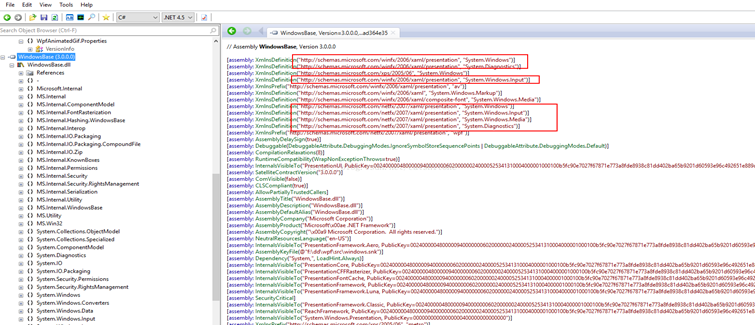namespace即"命名空间",VS.NET中的各种语言使用的一种代码组织的形式通过名称空间来分类,区别不同的代码功能,同时也是VS.NET中所有类的完全名称的一部分。
1、建立命名空间
我们创建一个默认的WPF程序,其会根据项目名称建立一个默认的命名空间
1 <Window x:Class="Example.MainWindow" 2 xmlns="http://schemas.microsoft.com/winfx/2006/xaml/presentation" 3 xmlns:x="http://schemas.microsoft.com/winfx/2006/xaml" 4 xmlns:d="http://schemas.microsoft.com/expression/blend/2008" 5 xmlns:mc="http://schemas.openxmlformats.org/markup-compatibility/2006" 6 xmlns:local="clr-namespace:Example" 7 mc:Ignorable="d" 8 Title="MainWindow" Height="350" Width="525"> 9 <Grid> 10 </Grid> 11 </Window>
其中以下代码当前应用程序的代表着命名空间,其组成方式是以xmlns:local开头,xmlns是XML Namespaces的缩写,代表xml命名空间。local代表本地xml所有在的命名空间,也就是"别名",就是对当前xml进行命名空间限定。所有命名空间都需以clr-namespace作为前缀,代表着当前的clr的命名空间限定,我们理解的意思是:"xml的本地命名空间等于clr命名空间且为Example"。
xmlns:local="clr-namespace:Example"
以下代码代表本类的类限定名,是命名空间+类名。
x:Class="Example.MainWindow"
其对应的代码命名空间如下:
namespace Example { public partial class MainWindow : Window { public MainWindow() { InitializeComponent(); } } }
2、引用命名空间
我们新建里一下项目com.albert.test,在当前项目引用com.albert.test项目,在xml定义如下:
<Window x:Class="Example.MainWindow" xmlns="http://schemas.microsoft.com/winfx/2006/xaml/presentation" xmlns:x="http://schemas.microsoft.com/winfx/2006/xaml" xmlns:d="http://schemas.microsoft.com/expression/blend/2008" xmlns:mc="http://schemas.openxmlformats.org/markup-compatibility/2006" xmlns:local="clr-namespace:Example" xmlns:albert="clr-namespace:com.albert.test;assembly=com.albert.test" mc:Ignorable="d" Title="MainWindow" Height="350" Width="525"> <Grid> </Grid> </Window>
其指定的xmlns方式为xmlns:albert="clr-namespace:com.albert.test;assembly=com.albert.test",其意思根据命名空间的定义,很容易读懂,albert代表命名空间的别名,assembly代表当前引用的程序集的命名,其对应这com.albert.test中的AssemblyInfo.cs文件中的描述。
代码中引入命名空间的方式和常规方式相似。
3、引入网址的命名空间
查看以上代码,我们发现,很多命名空间是以http协议的方式呈现,这种命名空间的目的是什么呢?用.NetReflector反编译WindowsBase.dll,可以看到,一个网址对应多个命名空间。
这个与传统的一个命名空间对应一个程序集的方式不太一样,我们定义一个自己的网址命名空间可以如下操作。
在之前新建的com.albert.test项目中的AssemblyInfo.cs增加下面一行
[assembly: XmlnsDefinition("http://www.albert.com", "com.albert.test")]
再回到主程序,我们可以引用如下命名空间
xmlns:local="clr-namespace:Example" xmlns:albert="http://www.albert.com" mc:Ignorable="d" Title="MainWindow" Height="350" Width="525">
我们将一个程序集的命名控制,转变为网址的命名空间,同时我们添加项目com.albert.min项目,也添加网址定义,如下:
[assembly: XmlnsDefinition("http://www.albert.com", "com.albert.min")]
分别在test项目中建立ClassTest和min项目中建立ClassMin,则直接引用http://www.albert.com地址命名空间,则可以同时引用两个命名空间。其效果如下:
<Window x:Class="Example.MainWindow" xmlns="http://schemas.microsoft.com/winfx/2006/xaml/presentation" xmlns:x="http://schemas.microsoft.com/winfx/2006/xaml" xmlns:d="http://schemas.microsoft.com/expression/blend/2008" xmlns:mc="http://schemas.openxmlformats.org/markup-compatibility/2006" xmlns:local="clr-namespace:Example" xmlns:albert="http://www.albert.com" mc:Ignorable="d" Title="MainWindow" Height="350" Width="525"> <Grid> <albert:ClassTest></albert:ClassTest> <albert:ClassMin></albert:ClassMin> </Grid> </Window>
由此可见,网址形式的命名空间等于将原来N个传统形式的命名空间,融合成一个网址,节约手工代码量。其核心目的是将同一个公司的命名空间,使用唯一的引用方式引入。